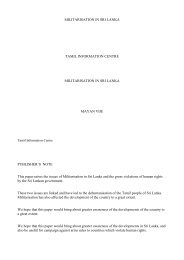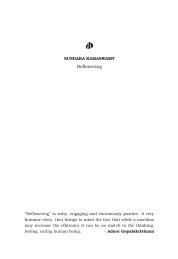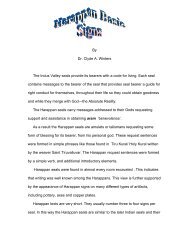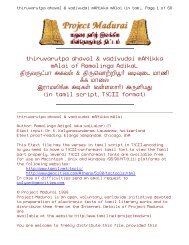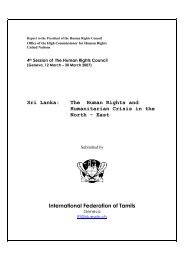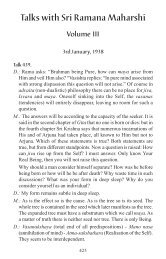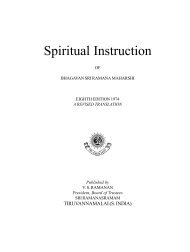Conflict in Sri Lanka: Ground Realities - Tamil Nation & Beyond
Conflict in Sri Lanka: Ground Realities - Tamil Nation & Beyond
Conflict in Sri Lanka: Ground Realities - Tamil Nation & Beyond
- No tags were found...
Create successful ePaper yourself
Turn your PDF publications into a flip-book with our unique Google optimized e-Paper software.
ecause of its vagueness to the <strong>Tamil</strong> m<strong>in</strong>d. Rather it could besaid that the <strong>Tamil</strong>s trusted the <strong>in</strong>tegrity of the <strong>Tamil</strong> leadership,which advocated the federal solution as what was best <strong>in</strong> their<strong>in</strong>terests. The S<strong>in</strong>halese elites viewed the Federal Party as then‘classic <strong>Tamil</strong> disposition’ of want<strong>in</strong>g to have the cake and eatit; they therefore refused to hear of federalism be<strong>in</strong>g the secondbest, or even as a compromise on a separate sovereign state.<strong>Tamil</strong> nationalism which was spread<strong>in</strong>g like a bush fire amongthe <strong>Tamil</strong>s of Ceylon. There could not have been a better recipefor the burgeon<strong>in</strong>g of <strong>Tamil</strong> nationalism than the IATR’s culturalactivities and the <strong>Tamil</strong> Federal Party’s gospel of the <strong>Tamil</strong>homeland and the unity of the <strong>Tamil</strong> speak<strong>in</strong>g peoples of Ceylon.Along with repression by the S<strong>in</strong>hala Buddhist State, there couldnot have been a greater fillip to <strong>Tamil</strong> aspirations <strong>in</strong> the aimfor a nation state. Thus culture fed nationalism and nationalismboosted patriotism. This <strong>Tamil</strong> nationalism expressed itself <strong>in</strong> anall-out struggle (porrattam <strong>in</strong> <strong>Tamil</strong>) aga<strong>in</strong>st the S<strong>in</strong>hala Buddhiststate. That was the term which the aspir<strong>in</strong>g <strong>Tamil</strong> youth reservedfor the state apparatus that sought governance over them.The Church and the TempleSett<strong>in</strong>g aside their historically <strong>in</strong>herited hostilities and differencesthe H<strong>in</strong>du-Christian elite leadership entered <strong>in</strong>to ma<strong>in</strong>stream ofthis nationalist struggle with one voice. H<strong>in</strong>du leaders and priestsjo<strong>in</strong>ed hands with their Christian counterparts <strong>in</strong> support<strong>in</strong>gand advanc<strong>in</strong>g the <strong>Tamil</strong> demand for separate statehood. NallurTemple and the Bishop’s House became the meet<strong>in</strong>g place ofthe lead<strong>in</strong>g citizens of Jaffna to express their protest aga<strong>in</strong>st theatrocities of the armed forces.In this <strong>Tamil</strong> national porrattam (struggle) the Catholic andProtestant churches <strong>in</strong> the <strong>Tamil</strong> areas and its hierarchy providedan active leadership with undaunted courage. The scholar-Bishopof Jaffna, Most Rev. Dr. Deogupillai stood solidly with his people<strong>in</strong> champion<strong>in</strong>g the cause for Human Rights, justice and equalitywith the late Rev. Dr. D. J. Ambalavanar, the Jaffna Bishop ofthe Church of South India who conv<strong>in</strong>c<strong>in</strong>gly argued the <strong>Tamil</strong>national question <strong>in</strong> India and abroad.50



